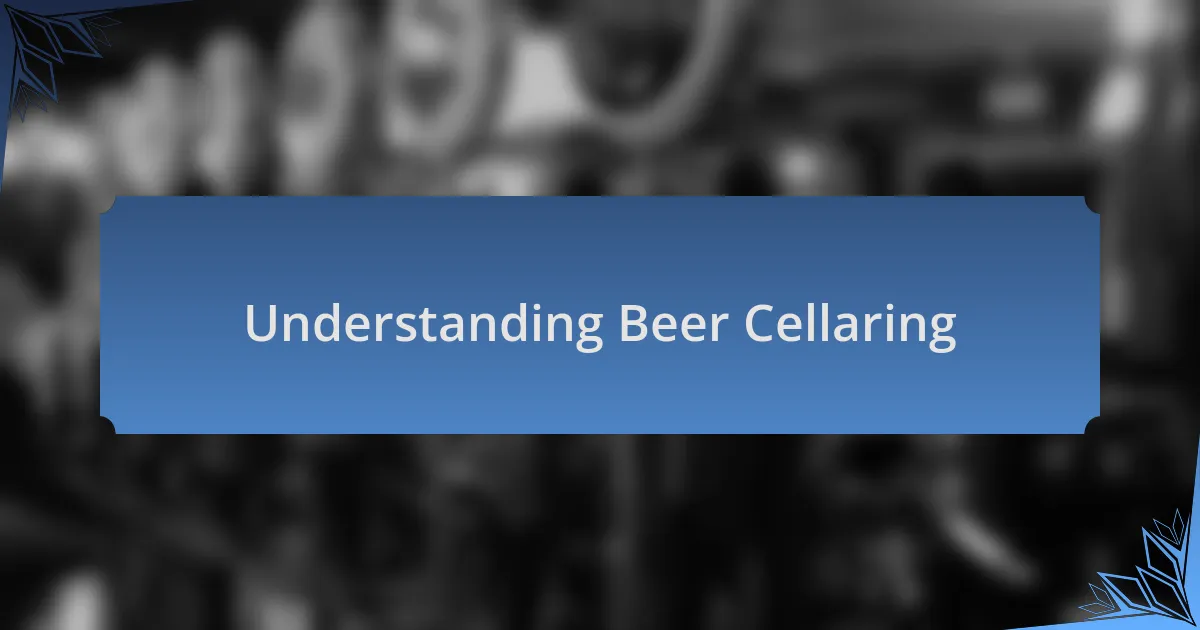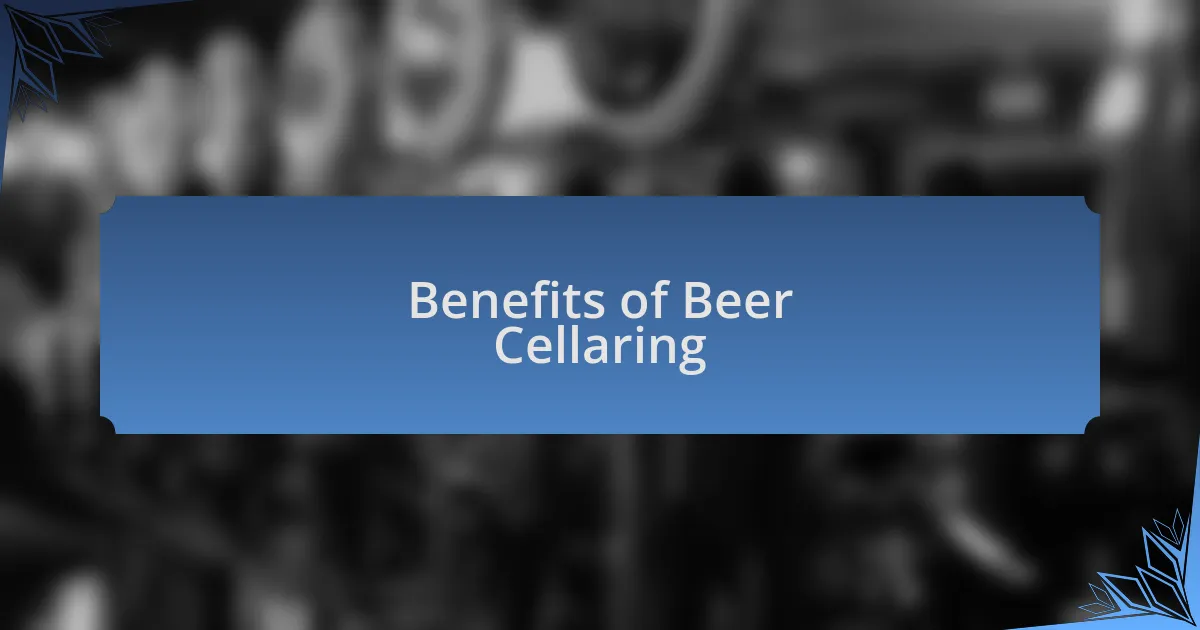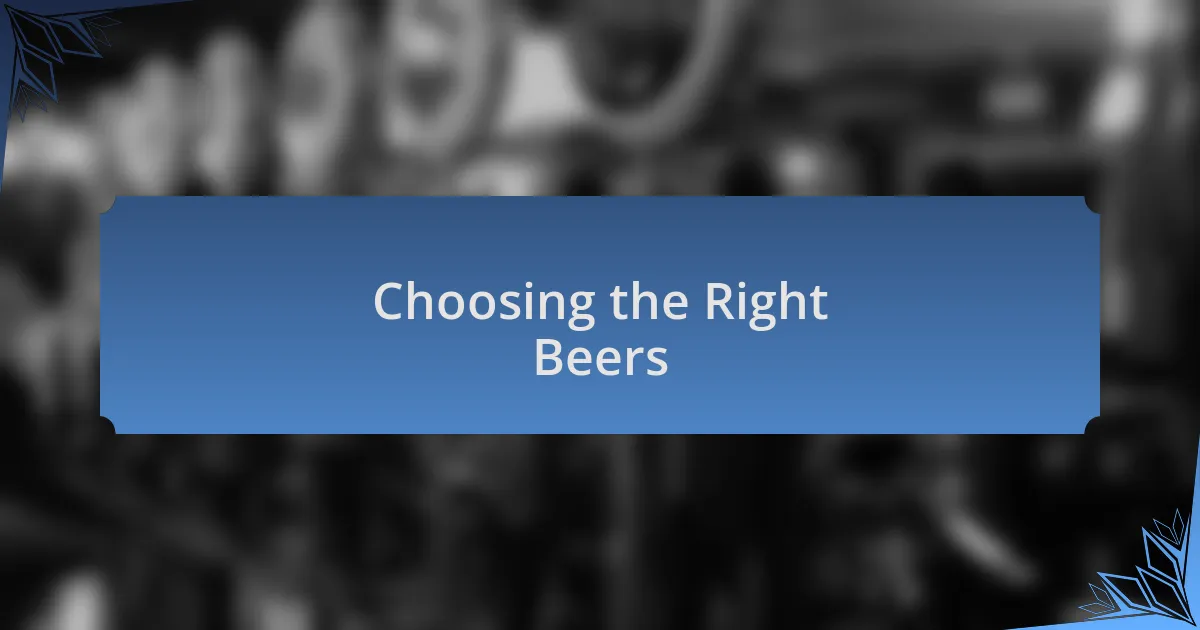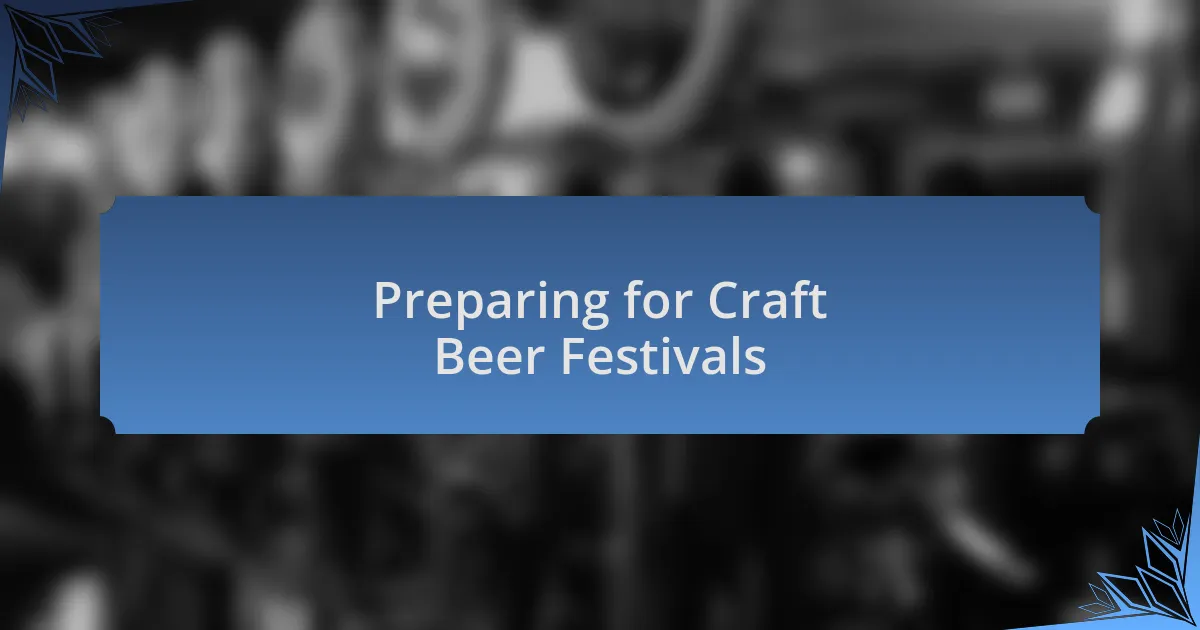Key takeaways:
- Beer cellaring enhances flavors over time, benefiting certain styles like barleywines and imperial stouts, while fresh beers like hoppy IPAs lose their vibrant characteristics when aged.
- Ideal cellaring conditions involve temperature control (around 50-55°F), appropriate humidity (60-70%), and limited light exposure to preserve beer quality.
- Regularly reviewing your collection and sampling older bottles while introducing new ones ensures excitement and enjoyment, creating memorable beer experiences.
- Engaging with beer communities and sharing experiences can enhance your knowledge and appreciation of different beer styles and cellaring techniques.

Understanding Beer Cellaring
Beer cellaring is the practice of aging beer in a controlled environment to enhance its flavors and aromas over time. It’s fascinating how certain beers, like barleywines or stouts, can transform dramatically with just a few months or years in a cellar. Have you ever cracked open a bottle from a special year and experienced a taste that took you back in time? I remember sipping on a vintage ale I had tucked away for a couple of years, and the rich, complex flavors that unfolded felt almost like a conversation with an old friend.
Understanding the nuances of beer cellaring requires knowing which styles benefit from aging. Some beers thrive on the delicate dance of time, developing deeper character, while others are best enjoyed fresh. Personally, I’ve made the mistake of aging a hoppy IPA, only to find that the vibrant aromatics faded away, leaving me with a more muted experience. Isn’t it intriguing how the journey of beer can teach us so much about patience and preservation?
The ideal conditions for cellaring are another crucial element. I’ve learned that temperature control, darkness, and humidity play significant roles in this delicate process. Picture your favorite bottle, resting quietly in a cool, dark corner of your home, eagerly awaiting the day you choose to enjoy it. Can you feel the anticipation? The relationship between time and flavor in beer is a beautiful reminder that good things often come to those who wait.

Benefits of Beer Cellaring
Cellaring beer isn’t just about storage; it’s an investment in flavor evolution. I still recall the first time I tried a barrel-aged stout that I had cellared for two years. The richness and depth of flavor were astonishing—it was like the beer and my palate had finally come to an understanding. Have you ever thought about how age can add intricate layers to a beer, making it feel almost like a craft narrative captured in a bottle?
One key benefit of beer cellaring is the ability to create unique tasting experiences. When I opened a bottle of sour ale that I had forgotten about for nearly three years, the tangy complexity surprised me. I could taste how the wild yeast had woven its magic over time, transforming a once straightforward brew into a vibrant symphony. Isn’t it incredible that a little patience can lead to such a rewarding experience?
Moreover, cellaring can diversify your collection, allowing for memorable moments with friends. I love hosting tasting nights where I share my cellared brews, and each bottle tells a story—from the year it was brewed to how it has evolved. These gatherings foster discussions, raise questions, and create cherished memories. What’s more satisfying than sharing a drink that has aged gracefully, just like the friendships around the table?

Choosing the Right Beers
When choosing the right beers for cellaring, I’ve learned to focus on specific styles that thrive with age. For instance, strong ales, imperial stouts, and sour beers often develop more complex flavors over time. I recall opening a barleywine after five years; the caramel and toffee notes had deepened, creating a luxurious experience I didn’t anticipate. Have you ever found a beer that surprised you with its transformation?
Another important consideration is the alcohol content. Beers with higher alcohol by volume (ABV), generally above 8%, tend to cellar better. I once picked up a Belgian quadrupel with a robust 10% ABV. After waiting two years, it was astonishing how the hot alcohol flavors mellowed, allowing the rich malty sweetness to shine through. Isn’t it fascinating how patience can redefine a beer?
Don’t overlook the freshness of your initial selection either. I’ve learned the hard way that beers meant for cellaring should be fresh when you start. One summer, I cellared a limited-release IPA and, unfortunately, it lost its vibrant hop character over time. Picking the right brews at the right stage can mean the difference between a delightful cellar find and a disappointing experience. What do you think—are you ready to curate your own beer collection?

Best Practices for Cellaring
When it comes to the actual cellaring process, temperature control is crucial. I remember when I first started cellaring, my garage seemed like the perfect spot, but I quickly learned that fluctuating temperatures can wreak havoc on the beer. A consistent temperature around 50-55°F is ideal; how do you imagine the flavors would change if the temperature varied too much?
Humidity is often overlooked but can significantly impact your beer’s longevity. I once had a bottle with a cork that dried out because the humidity was too low, which led to oxidation. Keeping humidity levels around 60-70% helps maintain the integrity of any corks you might be working with. Have you ever experienced oxidation in beer? It’s not just a buzzkill; it can completely ruin your carefully cellared treasures.
Lastly, I’ve found that less is often more when it comes to light exposure. I used to display my favorite bottles on a sunny shelf, only to realize that UV light can cause beer to age prematurely and alter its flavor profile. Now, my collection resides in a dark corner, where they’re safe from both direct light and prying eyes. Have you considered how light might be affecting your beer collection?

My Personal Cellaring Techniques
I’ve developed a technique that involves detailed labeling for each bottle I add to my cellar. When I pop the cap, I make a note of the date and any tasting notes. This simple practice has transformed my approach; looking back at my notes evokes memories of what I liked—or didn’t—about each beer. Have you ever wished you could revisit a specific beer experience? For me, this method has allowed me to track my preferences over time, enhancing my overall beer journey.
One thing I can’t stress enough is the importance of rotation. I learned the hard way that if I let my cellar become stagnant, I’d risk losing out on some fantastic brews. My approach now is to regularly taste and enjoy my older bottles while introducing newcomers. This ensures that the older beers don’t sit for too long and that I keep the excitement alive. Have you tried a bottle only to realize it’s past its prime? I’ve had my share of regrets, which is why rotation is now my mantra.
Another technique I rely on is seasonal assessment. I often evaluate my collection as the seasons change, considering what styles are best enjoyed at various times of the year. For instance, I might prioritize lighter, refreshing beers in the summer and rich stouts in the winter. This seasonal planning adds a layer of anticipation, making each tasting feel timely and special. How do you approach your beer choices throughout the year? For me, this strategy has created memorable moments tied to specific seasons and gatherings, deepening my appreciation for beer as an experience.

Lessons Learned from Cellaring
Cellaring beer has taught me patience—a virtue I didn’t fully appreciate until I watched a few bottles mature spectacularly over time. I remember trying a barleywine I tucked away for two years. When I finally cracked it open, the complex flavors that emerged left me in awe. Has there ever been a moment for you when time proved to be a key ingredient in an experience? For me, that beer was a reminder that some things genuinely get better with age.
Another lesson I learned is the significance of understanding each beer’s unique characteristics. Not all brews are meant for cellaring; some simply decline over time. I once stashed away a pale ale, only to discover it had lost much of its luster within months. This mishap prompted me to research styles more carefully, focusing on those that improve with age. Knowing which beers thrive in a cellar can greatly influence the success of my collection—do you know which of your favorite beers are worth aging?
Community insight has been a game-changer, too. Joining local tasting groups opened my eyes to the shared enthusiasm around cellaring. Listening to fellow enthusiasts share their experiences and recommendations has not only inspired me but also helped refine my own collection. I recall a conversation about a rare lambic that spurred me to seek it out—I felt a sense of camaraderie and excitement knowing that we were all on this journey together. Have you ever learned something invaluable from a beer-loving friend or group? This exchange of knowledge and passion truly enhances the cellaring experience, making it as rewarding as tasting itself.

Preparing for Craft Beer Festivals
Preparing for a craft beer festival involves careful consideration of what to bring and how to approach the event. I often find it helpful to create a checklist of beers I want to sample or share. Once, at a local festival, I forgot to note the breweries I was excited about and ended up feeling overwhelmed by the options. Have you ever faced a similar situation where too many choices made your decision harder? Taking a moment to jot down my favorites beforehand can really enhance the experience.
Another crucial aspect is ensuring proper storage for any bottles I plan to take home. I remember rushing home from a festival with a handful of limited releases, only to realize that I had left some in the sun for too long. This taught me the importance of bringing a cooler or insulated bag. Do you have a go-to method for transporting your beer? It’s a small detail, but it can make a big difference in preserving the quality of your treasures.
Lastly, engaging with fellow attendees can elevate the festival vibe. I love sharing my thoughts on new finds and hearing recommendations from others. At one festival, I struck up a conversation with a fellow enthusiast about sour beers, and they ended up introducing me to a brewery I hadn’t explored yet. Isn’t it amazing how these connections can deepen our appreciation for craft beer? Each interaction adds another layer of enjoyment to the festival, making it not just about the beer itself but also the community around it.